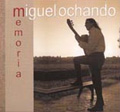Against all memory
| JUAN VERGILLOS
The strangest and most beautiful guitar recording of recent times. Strange, because it’s a marginal work due to the classic approach that abounds. To a baroque hallucinatory time, both at the discographic level, and the artistic one (not to mention social, political, etc.), Ochando responds with an untimely comeback. True unto himself. A strange work that goes against the current. Even with some contradictions in content, the work has many virtues. The least of these is no small gesture. Ochando’s record makes us dust off some predecessors, the old vinyl recordings, reeditions and originals: Montoya, Sabicas, Ricardo. But also Mario Escudero and Manuel Cano. Cano is in this “Memoria” (particularly the “Evocación de la guitarra de Ramón Montoya” from 1964; I heard it for the first time as an adolescent and actually thought Cano was playing with the same guitar that had been Ramón Montoya’s. And my ears, accustomed to Paco de Lucía, responded: “is this really flamenco?”). So Ochando’s record rejuvenated me 20 years. This is a record of solo guitar. But, like Mario Escudero, Ochando opens the recording with palmas, in addition to Cepillo’s cajón. Emilio Maya is on second guitar for a Piazzolla adaptation. And the voices of Enrique and Estrella Morente. The three collaborations are wonderful. And as independent pieces, they’re nothing less than masterpieces of nighttime and friendship (a slowly distilling art). They even break the unity of the work, the sobriety of the recording, the straightforward quality, the radicalness (which protests nothing…and everything). “Memoria” is worth more than a thousand manifestos. Like a declaration of principles. And then there are the emotions that saturate each and every note. Oh lady, come on in and let your hair down. To finish with the doubts and get on with what really matters, let’s begin with the album’s cover. That’s right, the cover…don’t let it fool you. It looks like a cover-up for the promotional recording for some department store. Don’t be fooled: you have before you a masterful work. Which, like Don Quixote, has its incongruences. That said, let’s move on to important issues (if there’s no producer, it’s because none was needed).
The creation of a new genre, the solo concert guitarist. Yes, all creation is an invention of the past. Sabicas on his own at eighty in Seville’s Reales Alcázares. That night the man from Pamplona played “El Sitio de Zaragoza” , as well as “Lo Que Vendrá”, both on this recording. Invention of past. Yes, they were crazy back then too (how modern the oldtimers were!), and, Ochando’s response to today’s madness (referring to flamenco guitar), is classic and lucid. A man can die on six strings, contain all the pain, all the anxiety, all the uncertainty, in the silence. The madness is on the inside. And it comes out in messages of clarity. Except the one who dies is the interpreter, the listener. What you are going to find in this still-life is a sobbing heart. His. This guitar variation is a settling of accounts with the past. That is why I am crying. This soleá is the pure front-line of he who stands near the grave. More than Joyce. More than Homer. Off the top of my head I can think of at least six recorded versions of Montoya’s rondeña, including the two by the maestro of Madrid himself, Chacón’s guitarist, Marchena’s guitarist. Is it possible to be so many things in life? Montoya only had half a one for the invention of accompaniment guitar and of solo concert guitar. It is the most wrenching work, and the most contained of flamenco guitar’s oral history. All Levante fits in here. Romantic salon guitar. On top of everything, including the six versions mentioned, Ochando’s version has plenty of room, without even trying, to rock us through our suffering. This is the revenge of time. This is opening our hands to our elders and realizing they gave us the best. Behind Montoya’s equilibrium. Behind Ricardo’s impetus. Behind Sabicas’ geometric charm. His soul is there. Our soul. His troubles. Splayed full out, shamelessly. Can there be any greater patrimony than to have the whole earth in our hands? The whole heart, with its surprising variety of pain, pleasure and fullfilment? The guitarist does not want to seduce. The guitarist has delivered his soul. I can’t remember when I’ve enjoyed a flamenco record this much… can’t stop listening to it. |


